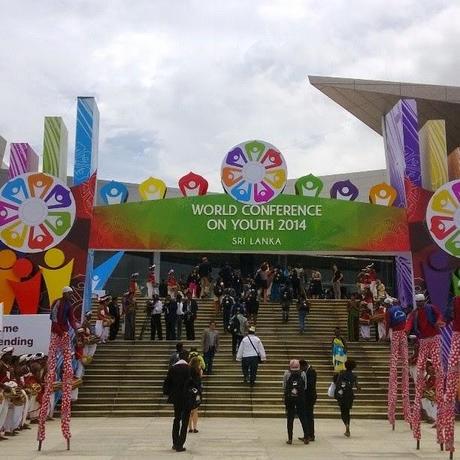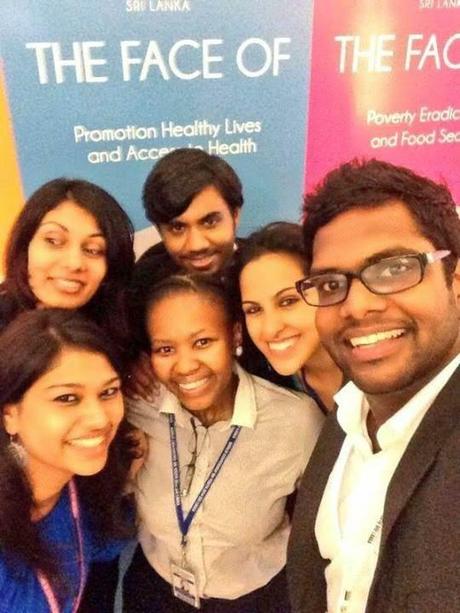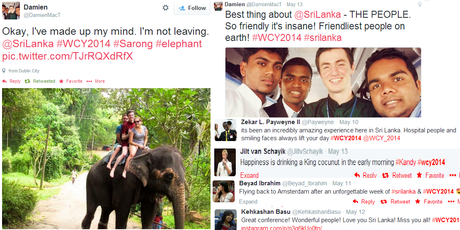
And little less than two weeks have passed since the opulent, breathtaking opening ceremony was held at MRICC, Hambantota to mark the start of the World Conference on Youth 2014. The opinions surrounding the conference have been widely expressed, are varied and continue to be so. It has been called everything from a 'carnival' to a 'historic milestone in youth advocacy'. I'm taking a stab at answering some of the questions having participated as a delegate and faciliator. Please note that this is from a purely personal point of view and do not represent any organization, government or other stakeholder.
So what was this whole thing about and why was it so 'historic'?
In 2000 the United Nations formulated the Millennium Development Goals (MDG's) which were 15 goals that were the cornerstone for development in the new millennium. Now, the Post 2015 Development Agenda (#post2015 on Twitter) is being formulated, effectively the next phase of development goals. This process is set to be much more inclusive with various groups and stakeholders meeting to give their inputs into Post 2015. There is a heavy focus on mainstreaming youth as young people make up a large proportion of the world's population, and at the same time a large number of their poor, under and unemployed - something the MDG's failed to address. There is clear demand that young people are seen as equal partners in development and not just beneficiaries of development.
WCY2014 was based around the 'Colombo Declaration' which is the first document that is authored by Youth and Governments jointly (in previous conferences there would be two documents). Youth was seated in negotiations and treated like separate member state. The facilitators and rapporteurs of the 14 sessions run on each day had the job of agreeing upon the three major suggestions from the youth delegates that would be submitted in negotiations. Negotiations then carried on with governments and youth modifying the document with a great deal of disagreement and compromise. Did we the youth see all of our suggestions included? No. Did we see half? Unlikely. But there were some big wins for youth in terms of education, gender equality and climate change. It was a chance for governments and youth to understand really where the other stands on certain issues and where one is willing to compromise and to what extent.
The Colombo Declaration will now be submitted to the General Assembly of the UN and when it passes (we currently see no reason why it will not) it will be considered as one of the major inputs to the Post 2015 Agenda.
What about the accusations of terrible logistics, lack of quality in terms of Sri Lankan delegates selected, and money wasted?
Logistics were badly organized and in my opinion there is little doubt money could have definitely been saved had this not happened. When it comes to the selection of Sri Lankan delegates, personally the delegates I had the fortune to meet were of good quality; but in the same breath I was sorry to note that some excellent youth were not given delegate positions. These people regardless showed up as self funded observers (they were not given meals or accommodation) and contributed. I am also aware that there were several delegates who 'freeloaded' not showing up for sessions and this in my opinion comes down to bad selection. We hurt no one but ourselves with this selfish behavior, all that happens is that there are less Sri Lankan voices speaking up to include suggestions on issues that impact us and our futures.
This conference as a whole however was not a waste of money by a long shot. If nothing else was achieved it was a gathering place for some of the best and brightest young minds in the world to meet, learn from each other and begin to create the future we want for out children.
In the end aren't all these policy discussions a waste of time? Shouldn't we just focus on grassroots work?
Grassroots work is exponentially important and indeed are the cornerstone of advocacy and development but that does not make policy irrelevant. In fact they go hand in hand - policy at a higher level must be changed and created to reflect the voices and needs of those at grassroots to ensure funding and laws are channeled there. Of course policy must be implemented at a grassroots level to be effective and those who advocate for these changes bear that responsibility as well. To paraphrase the brilliant Jayathma from her welcome address at the opening ceremony - don’t we want to be able to look at our children and know we did all that we could to give them the best world possible?
Didn't the 'selfies' and use of social media prove that youth are frivolous and only up for a good time?
To me this argument is irrelevant - it is possible to have a good time, take selfies and at the same time be socially conscious and committed. It was a youth focused conference and taking the 'youth' element out defeats the purpose. Were there some people who only attended and took selfies? Sure but it’s only in utopia that you wouldn’t see that - there are always people in any conference (high level meetings included) that are there only for the perks.

The members of the Sri Lankan United Nations Youth Advisory
Panel (UNYAP) taking a selfie with Ahmed Allendawi, the UN
Secretary General's Special Envoy on Youth

The Global Shapers of the Colombo Hub in a selfie
with the Founding Curator of the Swaziland Hub
What did Sri Lanka get out of this?
A member of the International Youth Led Task Force for WCY2014 and friend Senel Wanniarachchi does a great job of answering this in his blog post.
I will only add what fellow Global Shaper and Research Economist Anushka Wijesinha remarked on Facebook – “If nothing else was achieved but helping us rebrand Sri Lanka in the hearts and minds of over 1,200 international delegates, then we've achieved a lot. Especially at this juncture for Sri Lanka, with the international perceptions what they are. And given that the majority of the 1,200+ were youth, and they were sharing photos and status updates of being in Sri Lanka, on Facebook, twitter and Instagram, they've done more for brand Sri Lanka and Sri Lankan tourism than any recent tourism campaign could have possibly achieved”.

Ps: Have more questions? Think I missed out on something? Disagree? Tweet @sharasekaram or comment below and let me know!

